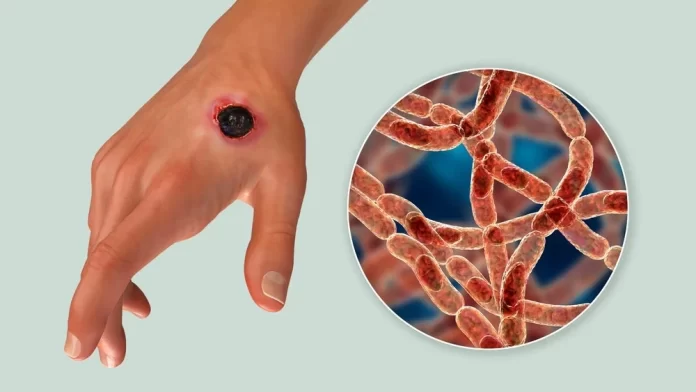Anthrax is a serious infectious disease caused by the bacterium Bacillus anthracis. It primarily affects livestock and wild animals, but humans can contract it through direct or indirect contact with infected animals or animal products. It can take different forms, depending on how the infection occurs.
Overview
- Forms of Anthrax: There are four main types of infection:
- Cutaneous Anthrax: The most common form, caused by skin contact with the bacteria or spores. It starts as a raised, itchy bump resembling an insect bite, which then develops into a painless sore with a black center.
- Inhalation Anthrax: The most serious form, contracted by breathing in spores. Early symptoms can resemble a cold or flu, but they progress to severe respiratory problems.
- Gastrointestinal Anthrax: Contracted by eating contaminated meat. It causes symptoms such as nausea, vomiting, abdominal pain, and severe diarrhea.
- Injection Anthrax: Rare and primarily associated with drug use, particularly in Europe. It occurs when the bacteria enter the body through a puncture wound caused by contaminated needles.
Symptoms
The symptoms vary depending on the type of infection:
- Cutaneous Anthrax: Starts with a small, painless sore that develops into an ulcer with a black center.
- Inhalation Anthrax: Symptoms may begin with a sore throat, mild fever, muscle aches, and fatigue, followed by severe breathing difficulties and shock.
- Gastrointestinal Anthrax: Symptoms include nausea, vomiting, fever, abdominal pain, and severe diarrhea, possibly with blood.
- Injection Anthrax: Symptoms may include severe swelling, redness at the injection site, and possible signs of sepsis.
Causes
It is caused by the bacterium Bacillus anthracis. Humans can contract the disease in several ways:
- Direct Contact: Touching infected animals, animal products, or contaminated soil.
- Inhalation: Breathing in spores from the bacteria, especially in environments where they are concentrated.
- Ingestion: Eating undercooked or contaminated meat from infected animals.
- Injection: Injecting drugs contaminated with anthrax spores.
Treatment
It is treated with antibiotics, which are most effective when started as early as possible:
- Cutaneous: Antibiotic treatment is usually effective.
- Inhalation: Requires aggressive antibiotic therapy, possibly including antitoxins.
- Gastrointestinal: Treated with antibiotics and supportive care.
- Injection: Requires aggressive antibiotic therapy and supportive care.
If left untreated, any form of it can be fatal.
Prevention
- Vaccination: Available for certain high-risk groups (e.g., military personnel, lab workers, and people who handle animals).
- Avoidance: Avoid contact with livestock and animal products in areas where anthrax is common.
- Protective Gear: Use protective clothing and equipment when handling animals or animal products.
- Food Safety: Ensure meat is cooked thoroughly, especially if it’s from an unknown source.
































